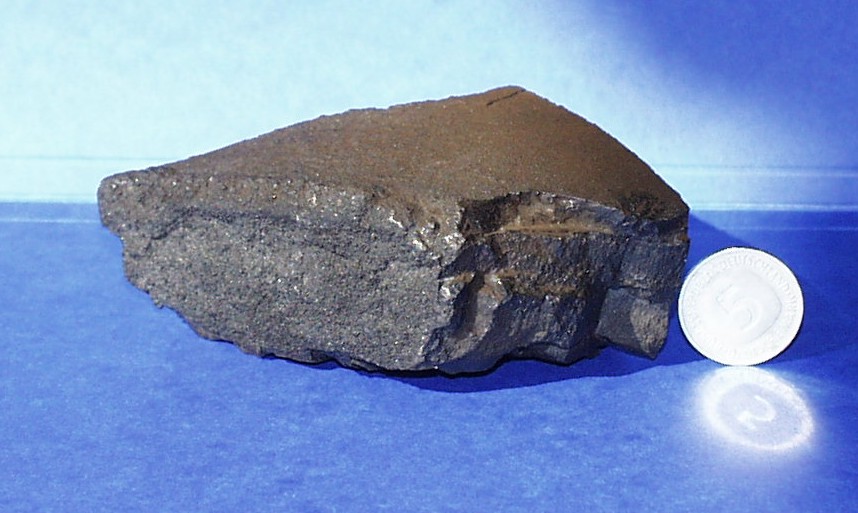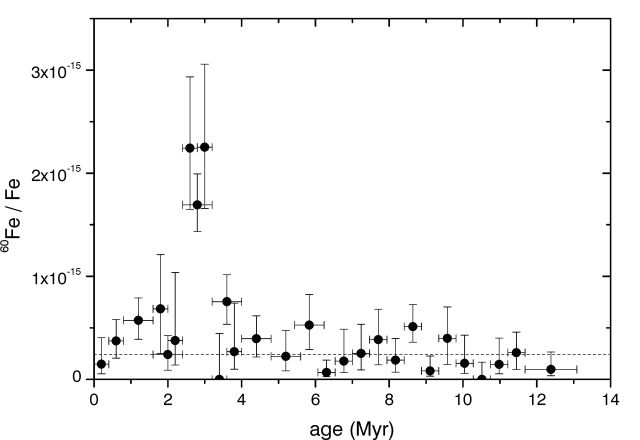Supernova produced iron-60 found in Pacific ocean
In samples originating from the Pacific ocean floor we have measured radioactive iron-60 isotopes, which were produced and ejected by a supernova three million years ago. The accompanying cosmic rays bombardment of the Earth's atmosphere may have caused the coeval global cooling that triggered major steps in human evolution.
Supernovae, i.e. explosions of massive stars at the end of their live, belong to the most violent events in the universe. During seconds they release an amount of energy comparable to that released by our sun in one billion years. Under these extreme conditions heavy, mostly radioactive nuclides are synthesized. After the explosion the bulk of that material is ejected into space, where the explosion front can expand up to hundreds of light years. If a supernova had occurred closer to Earth, the debris could have been directly deposited onto it. Therefore, the detection of supernova-produced material on Earth gives clear evidence for a "nearby" (i.e. close than a few hundred light years) explosion. However, supernovae are a rare phenomenon: on average there are only three explosions per century in our whole galaxy, "nearby" explosions are less frequent than one per million years. For this reason, our search for supernova debris had to cover a time span of many million years.
At the accelerator laboratory in Munich, where we used the ultra-sensitive method of accelerator mass spectrometry, we succeeded to detect radioactive iron-60 (half life: 1.5 million years) of supernova origin. A supernova can produce an iron-60 amounts of ten times our Earth's mass whereas the production inside the solar system is negligible. Therefore, a significant iron-60 signal on Earth is a unique signal for a nearby supernova.
Our samples were taken from a so-called deep-sea ferromanganese crust as depicted in figure 1.

It has been recovered from the Pacific ocean floor from a depth of 4830 meters. Here it grew for millions of years with a growth rate, which has been determined to be as low as 2.5 millimeters per million years. Therefore, the age of a layer of a certain depth can easily be determined, e.g. a layer ten millimeters below the crust's surface has an age around four million years. 28 of those layers have been measured, covering a time span from present to 13 million years. The results of this measurement series is shown in figure 2. Like expected, nearly all of the layers cannot be clearly distinguished from our measurement background (indicated by the dashed line). The three layers around three million years, however, have a significant iron-60 enhancement, which is fully compatible with the expected deposition from a supernova 100 light years away.

This well resolved signal allows the search for other plausible consequences at that time. The expanding explosion fronts of supernovae are the sites where cosmic rays gain energy: protons from the interstellar medium are accelerated in turbulent magnetic field to very high energies. Detailed simulations resulted in a cosmic ray enhancement for a period in the order of 100,000 years at the Earth's location. There are hints that cosmic rays interacting with our atmosphere produce cloud condensing nuclei, thus an enhanced cosmic ray flux might yield a global cooling. Based on other experiments (measurements of oxygen isotope ratios), it is commonly accepted, that such a long-term global cooling three million years ago took place, however, the explanations for it are controversial up to now. As a consequence of that global cooling the African climate shifted to more arid conditions which mediated speciation occurrences. Major steps in hominid evolution, being indispensable for the development of the homo sapiens, might have been triggered by a violent cosmic event three million years ago and a few million times more distant to us than our sun.
Klaus Knie
Reference:
K. Knie, G. Korschinek, T. Faestermann, E.A. Dorfi, G. Rugel and A. Wallner.
60Fe Anomaly in a Deep-Sea Manganese Crust and Implications for a Nearby Supernova Source
Physical Review Letters 93, 171103 (2004).